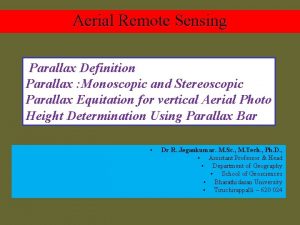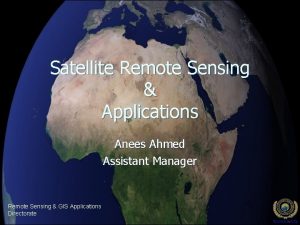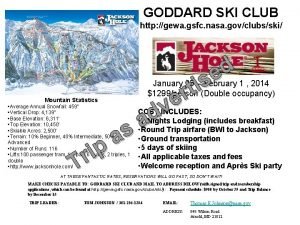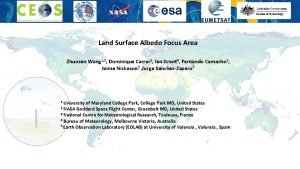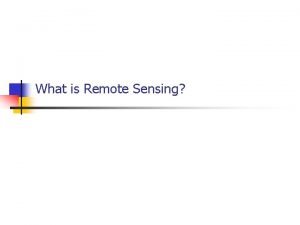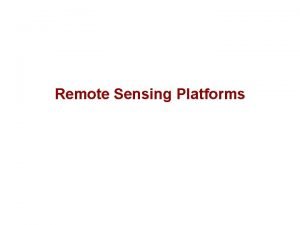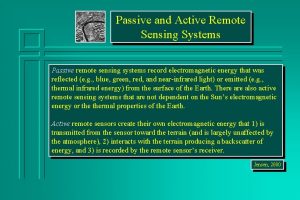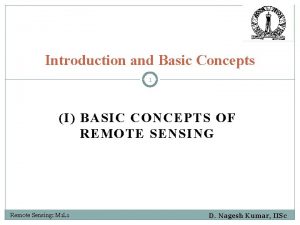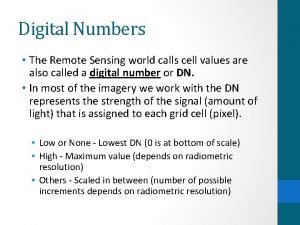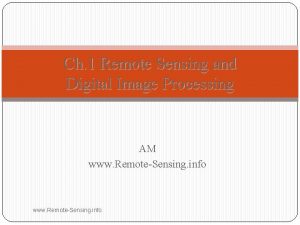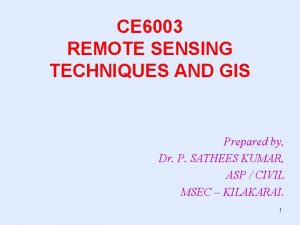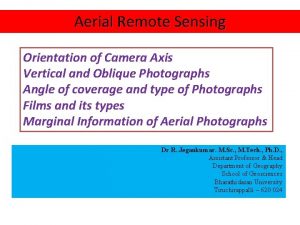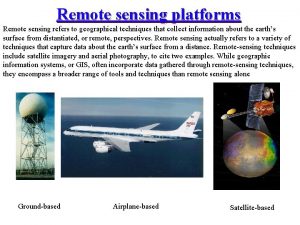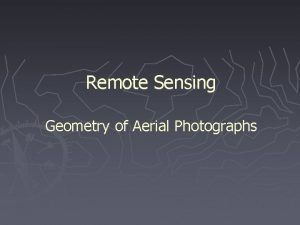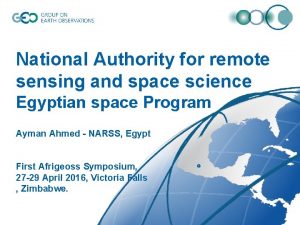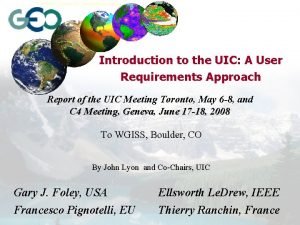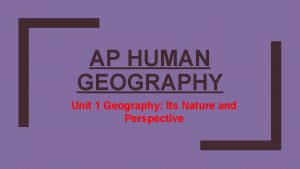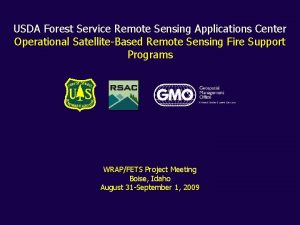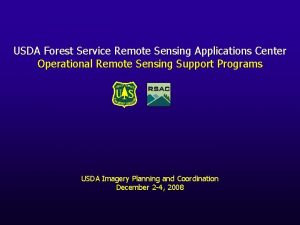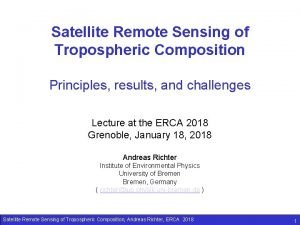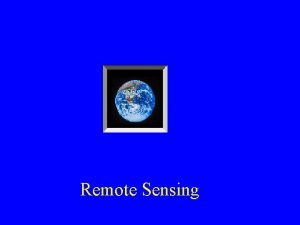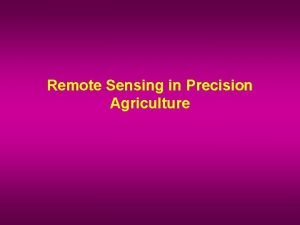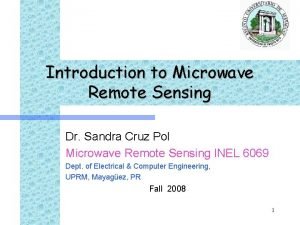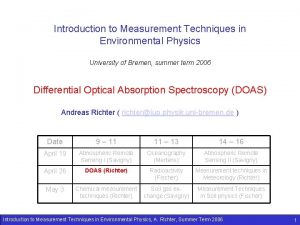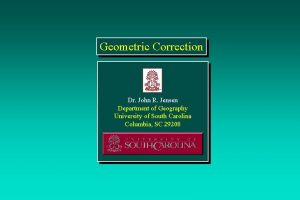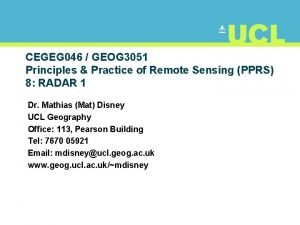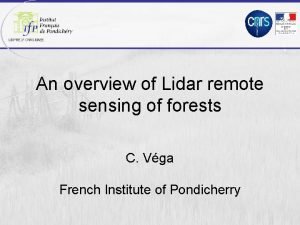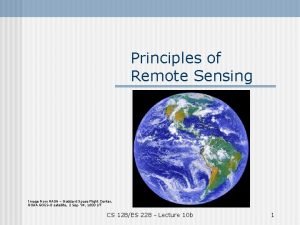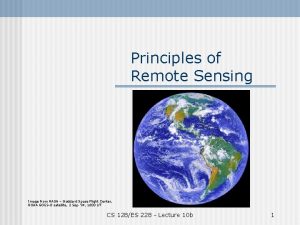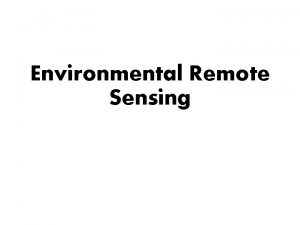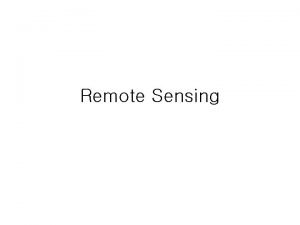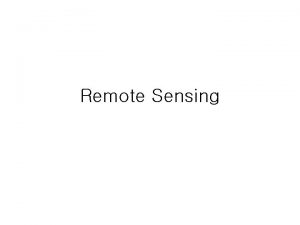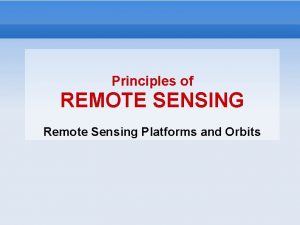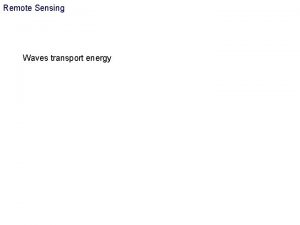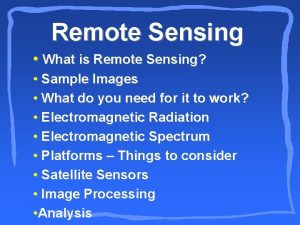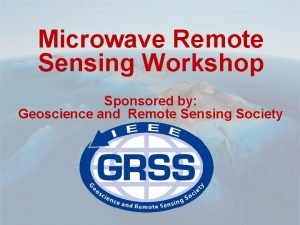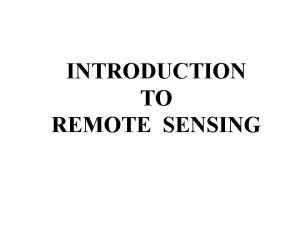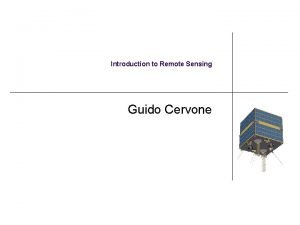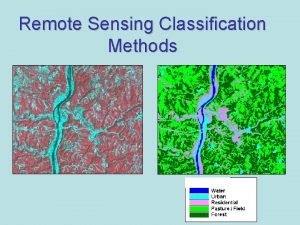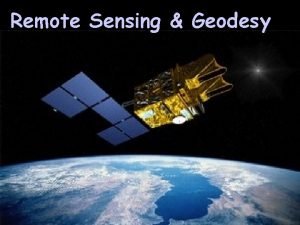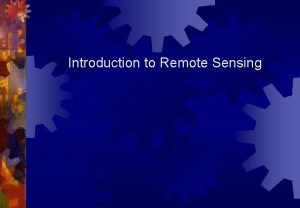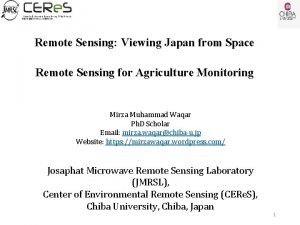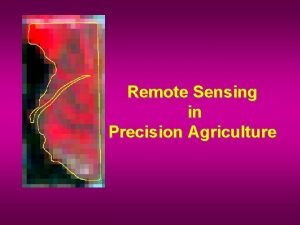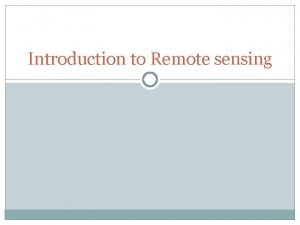Principles of Remote Sensing Image from NASA Goddard






























- Slides: 30

Principles of Remote Sensing Image from NASA – Goddard Space Flight Center, NOAA GOES-8 satellite, 2 Sep ’ 94, 1800 UT CS 128/ES 228 - Lecture 10 a 1

Scanning planet Earth from space CS 128/ES 228 - Lecture 10 a 2

A hierarchy of remote sensing n Satellite sensing n Aerial photography n Ground-truthing Image from Avery. Interpretation of Aerial Photographs. CS 128/ES 228 - Lecture 10 a 3

History of remote sensing n Earliest vehicle was …? n Tournachon (‘Nadar’) took 1 st aerial photograph in 1858 (since lost) n Earliest conserved aerial photograph: Boston, J. Black, 1860 n Early applications were in military reconnaissance CS 128/ES 228 - Lecture 10 a 4

WWII – heavy use of aerial reconnaissance Images: Avery. 1977. Interpretation of Aerial Photographs. 3 rd ed. Burgess Press, Minneapolis, MN. CS 128/ES 228 - Lecture 10 a 5

“Spy planes” & the Cold War CS 128/ES 228 - Lecture 10 a 6

Satellite sensing n Russian Sputnik (1957) - radio transmitter only n Rapid response by US: CORONA (1960) n Early applications: military reconnaissance CS 128/ES 228 - Lecture 10 a 7

Advantages of satellites n Wide coverage n Vertical (orthogonal) view at near-infinite height n Automated, 24/7 operation n Rapid data collection CS 128/ES 228 - Lecture 10 a 8

Spectral bands Three important spectral bands: n visible light n infrared radiation n microwave radiation Image from NASA 1987. SAR: Synthetic Aperture Radar. Earth Observing System, Vol. IIf. CS 128/ES 228 - Lecture 10 a 9

Classes of sensors Photographic n panchromatic n color Multi-spectral scanners § image scanned across sensors § sensors for many wavelengths Infrared (IR) § film (near IR) § thermal IR sensors for longer wavelengths Radar § RAdio Detection And Ranging § active imaging CS 128/ES 228 - Lecture 10 a 10

§ IR penetrates haze and light cloud Infrared cover sensors n can be used at night n used by military for camouflage detection n IR ‘signature’ often distinct from visible image CS 128/ES 228 - Lecture 10 a 11

Color IR film § Used with yellow (blueabsorbing) filter n 3 primary pigments, but not “true” (visible) color - green vegetation = red clear water = dark blue turbid water = bright blue soil = green urban areas = pale blue Top image: Committee on Earth Observation Satellites http: //ceos. cnes. fr: 8100/cdrom-98/ceos 1/irsd/content. htm Bottom image: Avery. 1977. Interpretation of Aerial Photographs. 3 rd ed. Burgess Press, Minneapolis, MN. CS 128/ES 228 - Lecture 10 a 12

Multispectral sensors n Visible + IR spectra n Comparison of film and electronic sensor spectral bands Top: Avery 1977. Interpretation of Aerial Photography. Burgess Publ. , Ninneapolis Bottom: ASTER Science page (http: //www. science. aster. ersdac. or. jp/users/parte 1/02 -5. htm#3) CS 128/ES 228 - Lecture 10 a 13

Landsat Images n Landsat 1 -4 launched 1972 – ’ 82; expired n Landsat 5 & 7 launched 1985 & 1999; both operational n TM: thematic mapper. - 7 spectral bands - designed primarily for ES themes http: //landsat. gsfc. nasa. gov/project/L 7 images. html CS 128/ES 228 - Lecture 10 a 14

TM Applications Band Spectral range (µm) “Color” Application 1 0. 45 – 0. 52 Blue-green Soil/vegetation separation 2 0. 52 – 0. 60 Green Reflection from vegetation 3 0. 63 – 0. 69 Red Chlorophyll absorption 4 0. 76 – 0. 90 Near IR Delineation of water bodies 5 1. 55 – 1. 75 Mid IR Vegetative moisture 6 10. 4 – 12. 5 Far IR Hydrothermal mapping 7 2. 08 – 2. 35 Mid IR Plant heat stress CS 128/ES 228 - Lecture 10 a 15

Hydrology example Images from Avery. Interpretation of Aerial Photographs. CS 128/ES 228 - Lecture 10 a 16

Radar sensors n active sensing n day & night, all weather n less affected by scattering (aerosols) Lo & Yeung, fig. 8. 13 n vertical or oblique perspective CS 128/ES 228 - Lecture 10 a 17

Uses of radar: altimetry n satellite-nadir distance n geoid & topographic measurements n sea elevation, tides & currents n wave/storm measurements Both images from NASA 1987. Altimetric System. Earth Observing System, Vol. IIh. CS 128/ES 228 - Lecture 10 a 18

Uses of radar: SAR n glaciology n hydrology n vegetation science n geology Image from NASA 1987. SAR: Synthetic Aperture Radar. Earth Observing System, Vol. IIf. CS 128/ES 228 - Lecture 10 a 19

Sensor resolution n Spatial: size of smallest objects visible on ground. Ranges from < 1 m to > 1 km. Inversely related to area covered by image n Spectral: wavelengths recorded. Ex. panchromatic film (~0. 2 – 0. 7 µm); Landsat Thematic Mapper bands (0. 06 to 0. 24 µm wide) n Radiometric: # bits/pixel. Ex. Landsat TM (8 bit); AVRIS (12 bit) n Temporal: for satellite, time to repeat coverage. Ex. Landsats 5 & 7 (16 days) CS 128/ES 228 - Lecture 10 a 20

Spatial resolution of satellite images A sampler of recent (civilian) satellites: Sponsor Satellite (instrument) Year Res. (m) NASA Landsat (Thematic Mapper) 1980 -90 s 30 (MSS) NASA & others EOS Terra (ASTER) 2000 15 - 90 (MSS) France SPOT-3 to 5 19932002 10 to 5 (pan) Space Imaging IKONOS-2 1999 1 (pan) 4 (MSS) Earth. Watch Quickbird-2 2001 0. 6 (pan) 2. 5 (MSS) CS 128/ES 228 - Lecture 10 a 21

Satellite image resolution Quickbird 2 n Commercial venture n 0. 63 m resolution n U. S. trying to discourage open access to finer resolution images Digitalglobe. com CS 128/ES 228 - Lecture 10 a 22

Satellite orbits Geostationary n 36, 000 km above equator Polar n varying heights n often in Sunsynchronous orbits Both diagrams from European Organisation for the Exploitation of Meteorological Satellites www. eumetsat. de/en/mtp/space/polar. html CS 128/ES 228 - Lecture 10 a 23

Satellite coverage Geostationary n no polar coverage n coverage is 24/7 n low ground resolution (~ 1 km) Polar n global coverage n coverage is discontinuous Both diagrams from European Organisation for the Exploitation of Meteorological Satellites www. eumetsat. de/en/mtp/space/polar. html CS 128/ES 228 - Lecture 10 a 24

Geostationary orbits Ex. GOES satellites n Meteorological satellites n GOES-8 at 75 o. W, GOES-9 at 135 o. W n 5 bands (1 visible, 4 thermal infrared) Image from NASA – Goddard Space Flight Center, NOAA GOES satellite, Hurricane Floyd, 15 Sep ‘ 99 CS 128/ES 228 - Lecture 10 a 25

Polar orbits Ex. Landsat & Terra satellites n 705 km height, ~100 minute orbit n 185 km swath n 16 day repeat n Sun-synchronous orbits (~0945 a. m. equator crossing) Orbit tracking data from NASA – http: //liftoff. msfc. nasa. gov/realtime/JTrack/eos. html, 5 Mar ‘ 03 CS 128/ES 228 - Lecture 10 a 26

Terra (and EOS) n Terra launched 1999 n Carries 5 instruments; the MSS imager is called ASTER (from Japan) n 14 spectral bands: - 3 VIS/near IR (15 m) - 6 short IR (30 m) - 5 thermal IR (90 m) Images from www. nasa. gov CS 128/ES 228 - Lecture 10 a 27

NYC drought The ASTER image pair depicts a 215 -square-kilometer (80 square-mile) area around Ashokan Reservoir in the Catskill Mountains, one of several Catskills reservoirs that supply water to the New York City metropolitan area. The images, taken September 18, 2000, and February 3, 2002, show a dramatic decrease in reservoir water level to the current 52 percent of capacity. Image courtesy NASA/GSFC/MITI/ERSDAC/JAROS, and U. S. /Japan ASTER Science Team CS 128/ES 228 - Lecture 10 a 28

Urban development study Ulaanbaatar, Mongolia - http: //corp. mmp. kosnet. com/CORP_CD_2004/ archiv/papers/CORP 2004_RADNAABAZAR_KUFF ER_HOFSTEE. PDF CS 128/ES 228 - Lecture 10 a Study used: SPOT images LANDSAT images ASTER images 1: 5, 000 maps 1: 10, 000 aerial photos 29

Ground truthing … … the fun part CS 128/ES 228 - Lecture 10 a 30
 Parallax remote sensing
Parallax remote sensing Remote sensing image
Remote sensing image Goddard ski club
Goddard ski club Albedo
Albedo Nasa goddard contractors
Nasa goddard contractors N-rays
N-rays Remote sensing platforms
Remote sensing platforms Active remote sensing
Active remote sensing Limitations of remote sensing
Limitations of remote sensing Digital number in remote sensing
Digital number in remote sensing Limitations of remote sensing
Limitations of remote sensing Idealized remote sensing system
Idealized remote sensing system Aggregation ap human geography
Aggregation ap human geography Remote sensing aphug
Remote sensing aphug Strip camera in remote sensing
Strip camera in remote sensing Ifov and fov in remote sensing
Ifov and fov in remote sensing Fiducial axis in aerial photography
Fiducial axis in aerial photography National authority for remote sensing and space sciences
National authority for remote sensing and space sciences Canadian centre for remote sensing
Canadian centre for remote sensing Ap human geography unit 1
Ap human geography unit 1 Remote sensing applications center
Remote sensing applications center Remote sensing applications center
Remote sensing applications center Remote sensing physics
Remote sensing physics Microwave remote sensing lecture notes
Microwave remote sensing lecture notes Remote sensing in precision agriculture
Remote sensing in precision agriculture Aerial photography in remote sensing pdf
Aerial photography in remote sensing pdf Introduction to microwave remote sensing
Introduction to microwave remote sensing Remote sensing physics
Remote sensing physics Geometric corrections
Geometric corrections Cegeg
Cegeg Full waveform lidar
Full waveform lidar
